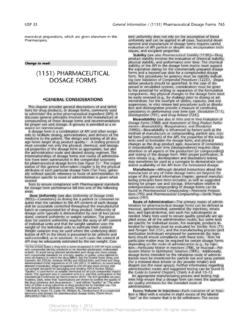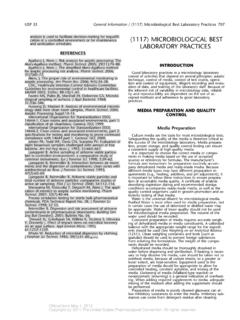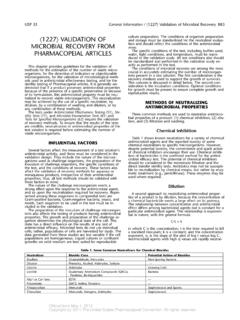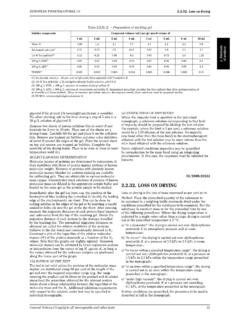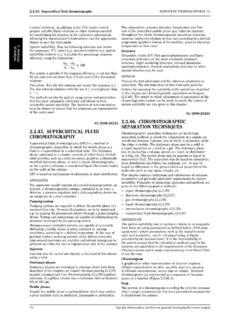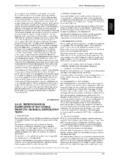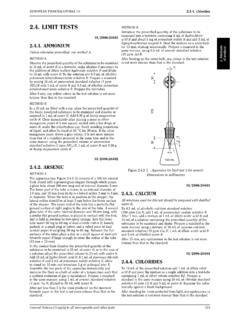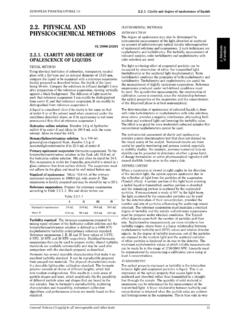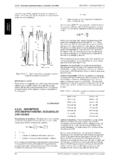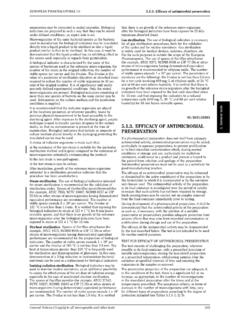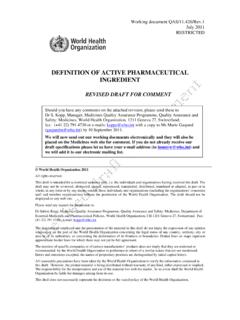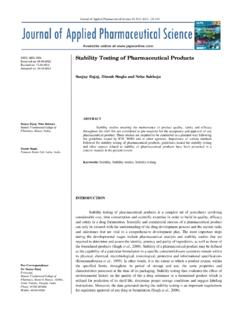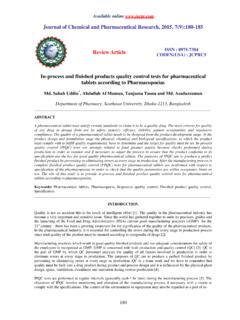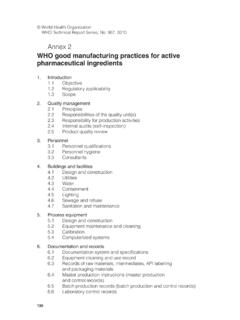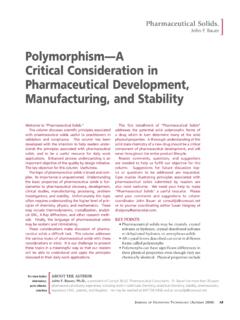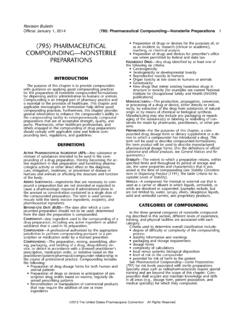Transcription of <1151> PHARMACEUTICAL DOSAGE FORMS - DrugFuture
1 USP 35 General Information / 1151 PHARMACEUTICAL DOSAGE Forms765maceutical preparations, which are given elsewhere in thistent uniformity does not rely on the assumption of and can be applied in all cases. Successful devel-opment and manufacture of DOSAGE FORMS requires carefulevaluation of API particle or droplet size, incorporation tech-niques, and excipient (see also PHARMACEUTICAL Stability 1150 ) Drugproduct stability involves the evaluation of chemical stability,physical stability, and performance over time. The chemicalChange to read:stability of the API in the DOSAGE form matrix must supportthe expiration dating for the commercially prepared dosageforms and a beyond-use date for a compounded DOSAGE 1151 PHARMACEUTICAL form.
2 Test procedures for potency must be stability indicat-ing (see Validation of Compendial Procedures 1225 ). Degra- DOSAGE FORMS dation products should be quantified. In the case of dis-persed or emulsified systems, consideration must be givento the potential for settling or separation of the formulationcomponents. Any physical changes to the DOSAGE form mustbe easily reversed ( , by shaking) prior to dosing or ad-sGENERAL CONSIDERATIONS ministration. For the example of tablets, capsules, and oralsuspensions, in vitro release test procedures such as dissolu-This chapter provides general descriptions of and defini-tion and disintegration provide a measure of continuingtions for drug products, or DOSAGE FORMS , commonly usedconsistency in performance over time (see Dissolution 711 ,to administer the active PHARMACEUTICAL ingredient (API).)
3 ItDisintegration 701 , and Drug Release 724 ).discusses general principles involved in the manufacture orBioavailability (see also In Vitro and In Vivo Evaluation ofcompounding of these DOSAGE FORMS and recommendationsDosage FORMS 1088 and Assessment of Drug Product Perfor-for proper use and storage. A glossary is provided as a re-mance Bioavailability, Bioequivalence, and Dissolutionsource on nomenclature. 1090 ) Bioavailability is influenced by factors such as theA DOSAGE form is a combination of API and often excipi-method of manufacture or compounding, particle size, crys-ents to facilitate dosing, administration, and delivery of thetal form (polymorph) of the API, the properties of the excip-medicine to the patient.
4 The design and testing of all dos-ients used to formulate the DOSAGE form, and physicalage FORMS target drug product A testing protocolchanges as the drug product ages. Assurance of consistencymust consider not only the physical, chemical, and biologi-in bioavailability over time (bioequivalence) requires closecal properties of the DOSAGE form as appropriate, but alsoattention to all aspects of the production (or compounding)the administration route and desired dosing regimen. Theand testing of the DOSAGE form. With proper justification, ininterrelationships of DOSAGE FORMS and routes of administra-vitro release ( , disintegration and dissolution) testingtion have been summarized in the compendial taxonomymay sometimes be used as a surrogate to demonstrate con-for PHARMACEUTICAL DOSAGE FORMS (see Figure 1).
5 2 The organ-sistent availability of the API from the formulated of this general information chapter is by the physicalManufacture Although detailed instructions about theattributes of each particular DOSAGE form (Tier Two), gener-manufacture of any of these DOSAGE FORMS are beyond theally without specific reference to route of administration. In-scope of this general information chapter, general manufac-formation specific to route of administration is given whenturing principles have been included, as well as for proper use and storage. Information relative toTests to ensure compliance with Pharmacopeial standardsextemporaneous compounding of DOSAGE FORMS can befor DOSAGE form performance fall into one of the followingfound in PHARMACEUTICAL Compounding Nonsterile 795 and PHARMACEUTICAL Compounding Sterile Prepa-Dose Uniformity (see also Uniformity of DOSAGE Unitsrations 797.)
6 905 ) Consistency in dosing for a patient or consumer re-Route of Administration The primary routes of admin-quires that the variation in the API content of each dosageistration for PHARMACEUTICAL DOSAGE FORMS can be defined asunit be accurately controlled throughout the manufacturedmucosal, gastrointestinal, parenteral (by injection), inhala-batch or compounded lot of drug product. Uniformity oftion, and topical/dermal, and each has subcategories asdosage units typically is demonstrated by one of two proce-needed. Many tests used to ensure quality generally are ap-dures: content uniformity or weight variation. The proce-plied across all of the administration routes, but some testsdure for content uniformity requires the assay of API contentare specific for individual routes.
7 For example, products in-of individual units and that for weight variation uses thetended for injection must be evaluated for Sterility Tests 71 weight of the individual units to estimate their Pyrogen Test 151 , and the manufacturing process (andWeight variation may be used where the underlying distri-sterilization technique) employed for parenterals (by injec-bution of API in the blend is presumed to be uniform andtion) should ensure compliance with these tests. Tests forwell-controlled, as in solutions. In such cases the content ofparticulate matter may be required for certain DOSAGE formsAPI may be adequately estimated by the net weight. Con-depending on the route of administration ( , by injec-1In the United States a drug with a name recognized in USP NF must complytion Particulate Matter in Injections 788 , or mucosal Par-with compendial identity standards or be deemed adulterated, misbranded,ticulate Matter in Ophthalmic Solutions 789 ).
8 Additionally,or both. To avoid being deemed adulterated such drugs also must complywith compendial standards for strength, quality, or purity, unless labeled todosage FORMS intended for the inhalation route of adminis-show all respects in which the drug differs. See the Federal Food, Drug, andtration must be monitored for particle size and spray patternCosmetic Act (FDCA), Sections 501(b) and 502(e)(3)(b), and Food and Drug(for a metered-dose inhaler or dry powder inhaler) andAdministration (FDA) regulations at 21 CFR In addition, to avoid beingdroplet size (for nasal sprays). Further information regardingdeemed misbranded, drugs recognized in USP NF also must comply withcompendial standards for packaging and labeling, FDCA Section 502(g).
9 Administration routes and suggested testing can be found in Quality is used herein as suitable shorthand for all such compendial require-the Guide to General Chapters, Charts 4 8 and 10 This approach also is consistent with and FDA participation in theAn appropriate manufacturing process and testing regi-International Conference on Harmonization (ICH). The ICH guideline on spec-ifications, Q6A, notes that specifications are chosen to confirm the quality ofmen help ensure that a DOSAGE form can meet the appropri-the drug substance and drug product and defines quality as The suita-ate quality attributes for the intended route ofbility of either a drug substance or drug product for its intended use.
10 Includes such attributes as identity, strength, and purity. 2 Marshall K, Foster TS, Carlin HS, Williams RL. Development of a compendialExcess Volume in Injections Each container of an Injec-taxonomy and glossary for PHARMACEUTICAL DOSAGE FORMS . Pharm is filled with a volume in slight excess of the labeled2003;29(5):1742 1752. size or the volume that is to be withdrawn. The excessOfficial from May 1, 2012 Copyright (c) 2011 The United States Pharmacopeial Convention. All rights from by nEwp0rt1 on Sat Dec 03 01:12:00 EST 2011766 1151 PHARMACEUTICAL DOSAGE FORMS / General InformationUSP 35 Figure 1. Compendial Taxonomy for PHARMACEUTICAL DOSAGE recommended in the accompanying table are usu-Identification Identification tests are discussed in theally sufficient to permit withdrawal and administration of theGeneral Notices and Requirements.
